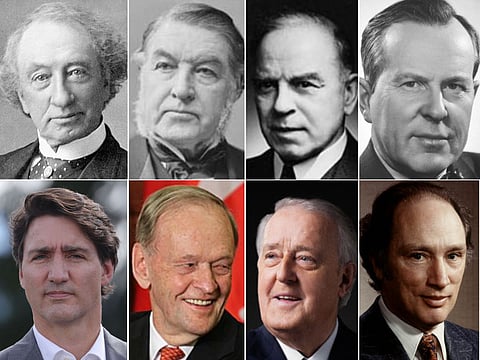The fall of power: Canadian Prime Ministers who resigned
Trudeau is not the first, nor likely the last, Canadian PM to quit his post: Here’s why

Canadian Prime Minister Justin Trudeau announced his resignation on January 6, 2025, after nearly a decade in office. What happens next?
In Canada, the resignation of a Prime Minister marks a significant political event. It also underscores the fluidity of its parliamentary democracy.
Leaders may resign for various reasons (i.e. perceived loss of mandate, personal choice, scandal). The process is so structured as to ensure stability in Canada’s enduring parliamentary system.
Since Confederation (1867), 23 Canadian prime ministers have been "called upon" by the governor general. Eight have quit their posts.
But it also highlights the importance of maintaining confidence in the continuity of governance.
So leadership transitions can occur without necessitating a general election in Canada.
Why did Trudeau quit his job?
A number of factors, according to local media reports:
One: Trudeau's approval ratings plummeted to approximately 20 per cent, with the Liberal Party’s voter intent dropping to 16 per cent by end-2024.
Two: His leadership is beset by burning issues – including reported shortages in affordable housing, persistent inflation, and a worsening economic outlook.
Three: Economic policy snags. Critics pointed to rising living costs and dissatisfaction with immigration policies as factors contributing to public discontent. The departure of Finance Minister Chrystia Freeland in December 2024, following disagreements over fiscal policies, intensified internal pressures on Trudeau's leadership.
Four: Frustration and discontent. While he championed causes like climate action, gender equality, and Indigenous reconciliation early in his career, he became a lightning rod for frustration and discontent as time passed. Detractors blame him for a range of grievances, some rooted in reality and others in unfounded conspiracy theories.
Five: Party politics. In October 2024, a group of 24 Liberal MPs signed a letter urging Trudeau to resign, expressing concerns over his leadership and the party's declining fortunes. He has been trailing behind opposition Conservatives. This has prompted a crisis of confidence in his leadership arose – both within his party and among the public.
This culminated in Trudeau's decision to step down on Tuesday, saying he will stay on until his Liberal Party picks a replacement.
Precedents
There are several precedents in Canada of Prime Ministers who have resigned.
Here are some notable examples:
1. Sir John A. Macdonald (1873)
Sir John A. Macdonald, Canada’s first Prime Minister, resigned during the Pacific Scandal. This political controversy arose from allegations that his government had accepted bribes from contractors seeking to build the Canadian Pacific Railway. He returned to power in a later election, demonstrating the resilience of his political career.
2. Sir Charles Tupper (1896)
Sir Charles Tupper resigned after serving as Prime Minister for only 69 days, the shortest term in Canadian history. His Conservative Party lost the general election, and he stepped aside to make way for Wilfrid Laurier's Liberal government.
3. William Lyon Mackenzie King (1948)
William Lyon Mackenzie King, Canada’s longest-serving Prime Minister, voluntarily resigned while still in office. He stepped down after decades of leadership and passed the baton to Louis St. Laurent, his chosen successor.
4. Lester B. Pearson (1968)
Lester B. Pearson announced his resignation as Prime Minister after leading the Liberals through two successive minority governments. Pearson stepped aside at the height of his political achievements, paving the way for Pierre Trudeau.
5. Pierre Trudeau (1984)
Pierre Trudeau announced his resignation after 16 years as Prime Minister, deeply influencing Canadian politics and society. His decision marked the end of an era, leading to the selection of John Turner as his successor.
6. Brian Mulroney (1993)
Brian Mulroney resigned following declining popularity and growing discontent with his government, partly related to the failures of the Meech Lake and Charlottetown constitutional accords and the introduction of the unpopular Goods and Services Tax (GST).
7. Jean Chrétien (2003)
Jean Chrétien stepped down after over a decade as Prime Minister, voluntarily resigning amidst an internal power struggle within the Liberal Party. Paul Martin succeeded him.
Sign up for the Daily Briefing
Get the latest news and updates straight to your inbox


